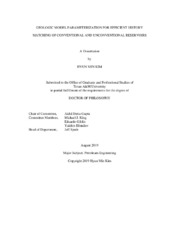| dc.description.abstract | Proper characterization of heterogeneous rock properties and natural/induced fracture properties is essential for optimizing field development plan and reliable estimation of Estimated Ultimate Recovery (EUR) in conventional and unconventional reservoirs. It is achieved by reconciling the geologic model to the dynamic production and pressure data, otherwise known as history matching. However, history matching of high resolution reservoir models with heterogeneous features and complex fracture properties is challenging because it poses non-uniqueness and stability issues of the highly underdetermined problems. This dissertation proposes novel reservoir model parameterization methods to regularize the ill-posed problem and enhance the efficiency of history matching. We also show practical feasibility of the proposed method by various field cases. First, the spatial properties of rock and fluid are simultaneously calibrated by grid adjacency-based parameterizations to seismic and pressure data of a heavy oil reservoir in Peace River field, Canada. A novel approach is proposed to integrate frequent time lapse seismic data into high resolution reservoir models based on the seismic onset times. Multiobjective genetic algorithm (MOGA) is utilized to address potential conflicts between seismic and pressure match. We demonstrate the feasibility and robustness of the history matching workflow with MOGA and simultaneous property calibrations in the parameterized transform domain.
Second, a novel multi-resolution parameterization is developed to further improve the regularization when the production data resolution is variant in a reservoir. The multiresolution parameterization adjusts the modal frequencies or resolutions of basis functions to comply with the various data resolutions. Hence, it better regularizes the undermined history matching problem compared to previous studies. Third, the grid adjacency-based parameterization is extended to parameterize reservoir models with various fracture geometries simulated by embedded discrete fracture model (EDFM). Analytical basis coefficient sensitivity to production data is calculated with the resulting basis and streamline-based sensitivity. Employing a hierarchical multi-scale workflow and the analytic sensitivity, matrix and fracture properties in EDFM are efficiently calibrated with the proposed parameterization. | en |


